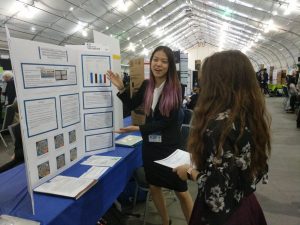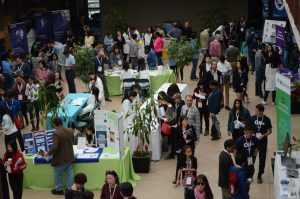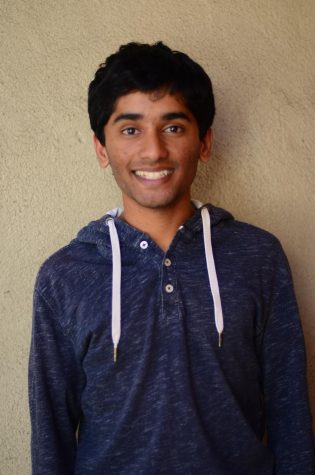Freshmen researchers reflect on engineering project to test types of biodegradable material
Freshmen Alice Feng and Arely Sun stand in front of an Environmental Engineering poster at the 2018 California Science and Engineering Fair. Their project, which eventually won first place, was titled “The Effect of Mushroom Species and Substrates on the Properties of a Novel Biodegradable Material: Mycelium.”
January 20, 2019
Attention to research at the upper school often focuses on the achievements of upperclassmen, like with the results of the recent Regeneron Science Talent Search. But research experience and success is not exclusive to only juniors and seniors: freshman Alice Feng, for her part, has already picked up a national championship.
Alice won first place in the Engineering category at the 2018 Broadcom MASTERS finalists science competition, which took place from Oct. 19 to Oct. 24 in Washington D.C., for an eight grade science research project she conducted with Arely Sun (9) titled “The Effect of Mushroom Species and Substrates on the Properties of a Novel Biodegradable Material: Mycelium.”
“Mycelium is basically the root of a mushroom; it’s made out of cotton-like things called hyphae. Mycelium has ability to bind particles together,” Alice said. “[In the project,] mycelium grows on different types of agricultural waste products, which are all completely organic, which means that they are beneficial to the environment and also won’t harm the environment.”
The project’s main focus was to test and analyze the various properties of the materials created when mycelium interacted with different types of agricultural waste product, as Alice notes, due to a lack of extensive testing on the properties of mycelium materials.
“We tested different combinations of mushroom species grown on agricultural waste product to compare their strength, insulation, soundproofing, and electromagnetic radiation shielding,” Alice said. “We also tested how they would affect plants when [the combinations] were put in the soil of the plants, and also how well they would fare in liquids of different pH values.”
Alice and Arely found that the products generated had impressive results due to its potential as a material as well as its organic, environmentally friendly method of creation.
“It turns out not only are these bricks [of mycelium material] durable and lightweight, they also kind of act like a fertilizer and they promote plant growth,” Arely said. “They can be used to replace wood, styrofoam, and possibly cement in the future.”
The inspiration for the project came from a visit to the Tech Museum, a museum of science and technology located in San Jose.
“I go to the Tech Museum and other science museums a lot, and the Tech Museum had a really small exhibit on mycelium. I was really interested in it because I thought it had a lot of potential,” Alice said. “I did some more research on it, and that’s how my partner and I came up with the project.”
After competing in the California Science and Engineering Fair as a team, Alice and Arely both qualified for the Broadcom MASTERS Top 300, and Alice went on to the Broadcom MASTERS finalists week competition. There, while participating in activities from coding with a Raspberry Pi board to designing shark trackers, Alice found that in the final stage of her journey, the emphasis was placed on teamwork.
“We were all put into teams — there are six teams of five people in each team — and we just stayed with this team for the week we were there,” Alice said. “Each team was pretty diverse: people from across the country from different grade levels and both genders. It was really interesting to see the different people there.”
Though the project has already yielded successful results, there are still many ways that Alice and Arely see to extend their project given additional resources.
“If we had a lab, we would try to genetically modify the mycelium to give the mycelium material even more properties, to grow even faster, and to reduce the risk of contamination,” Alice said.


















![“[Building nerf blasters] became this outlet of creativity for me that hasn't been matched by anything else. The process [of] making a build complete to your desire is such a painstakingly difficult process, but I've had to learn from [the skills needed from] soldering to proper painting. There's so many different options for everything, if you think about it, it exists. The best part is [that] if it doesn't exist, you can build it yourself," Ishaan Parate said.](https://harkeraquila.com/wp-content/uploads/2022/08/DSC_8149-900x604.jpg)




![“When I came into high school, I was ready to be a follower. But DECA was a game changer for me. It helped me overcome my fear of public speaking, and it's played such a major role in who I've become today. To be able to successfully lead a chapter of 150 students, an officer team and be one of the upperclassmen I once really admired is something I'm [really] proud of,” Anvitha Tummala ('21) said.](https://harkeraquila.com/wp-content/uploads/2021/07/Screen-Shot-2021-07-25-at-9.50.05-AM-900x594.png)







![“I think getting up in the morning and having a sense of purpose [is exciting]. I think without a certain amount of drive, life is kind of obsolete and mundane, and I think having that every single day is what makes each day unique and kind of makes life exciting,” Neymika Jain (12) said.](https://harkeraquila.com/wp-content/uploads/2017/06/Screen-Shot-2017-06-03-at-4.54.16-PM.png)








![“My slogan is ‘slow feet, don’t eat, and I’m hungry.’ You need to run fast to get where you are–you aren't going to get those championships if you aren't fast,” Angel Cervantes (12) said. “I want to do well in school on my tests and in track and win championships for my team. I live by that, [and] I can do that anywhere: in the classroom or on the field.”](https://harkeraquila.com/wp-content/uploads/2018/06/DSC5146-900x601.jpg)
![“[Volleyball has] taught me how to fall correctly, and another thing it taught is that you don’t have to be the best at something to be good at it. If you just hit the ball in a smart way, then it still scores points and you’re good at it. You could be a background player and still make a much bigger impact on the team than you would think,” Anya Gert (’20) said.](https://harkeraquila.com/wp-content/uploads/2020/06/AnnaGert_JinTuan_HoHPhotoEdited-600x900.jpeg)

![“I'm not nearly there yet, but [my confidence has] definitely been getting better since I was pretty shy and timid coming into Harker my freshman year. I know that there's a lot of people that are really confident in what they do, and I really admire them. Everyone's so driven and that has really pushed me to kind of try to find my own place in high school and be more confident,” Alyssa Huang (’20) said.](https://harkeraquila.com/wp-content/uploads/2020/06/AlyssaHuang_EmilyChen_HoHPhoto-900x749.jpeg)













